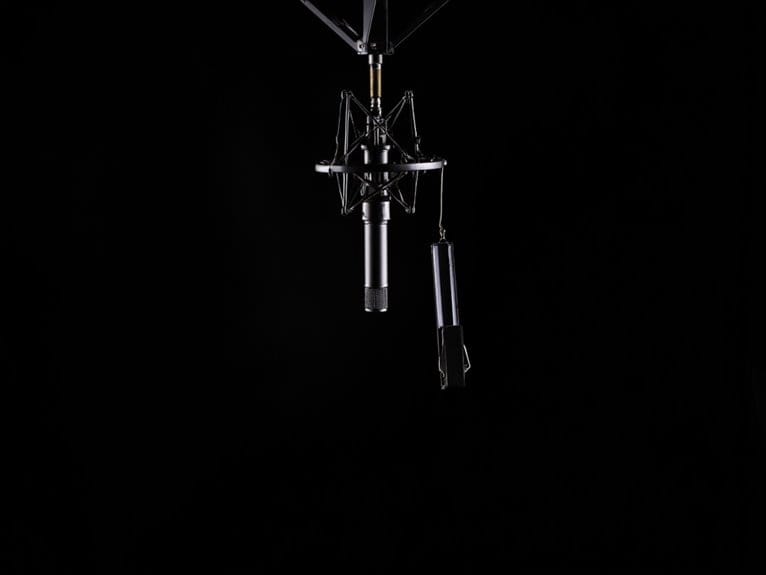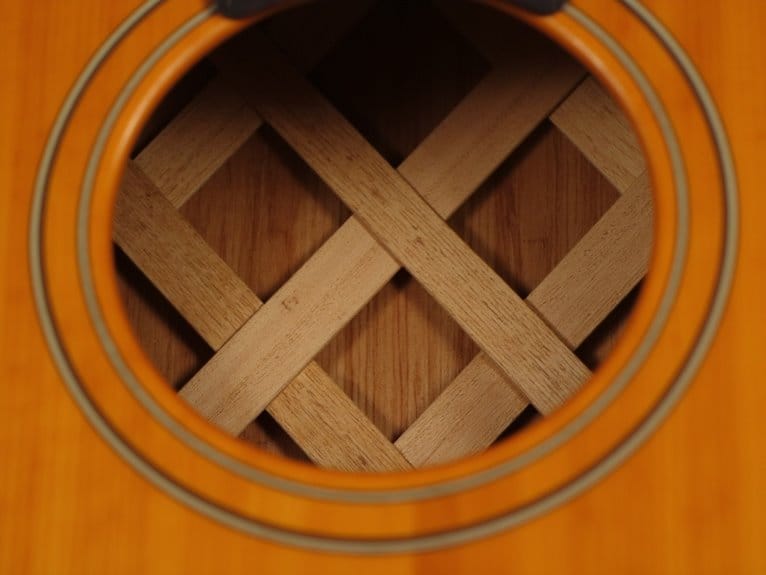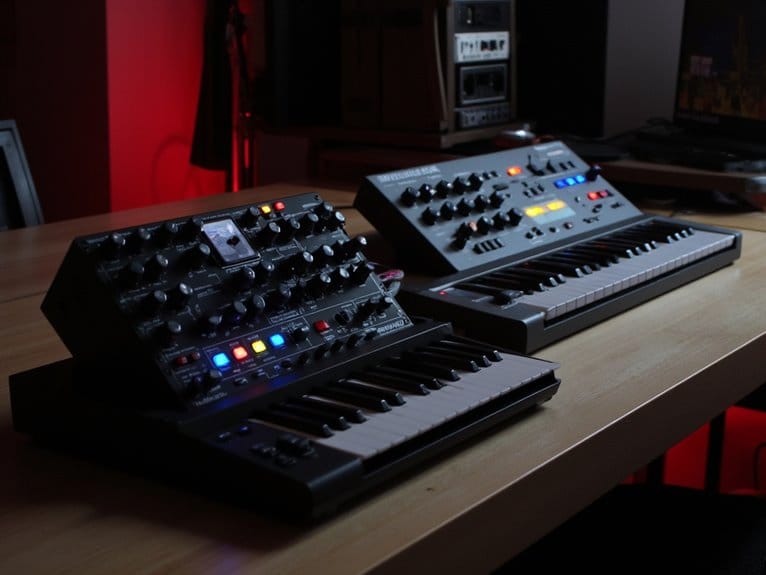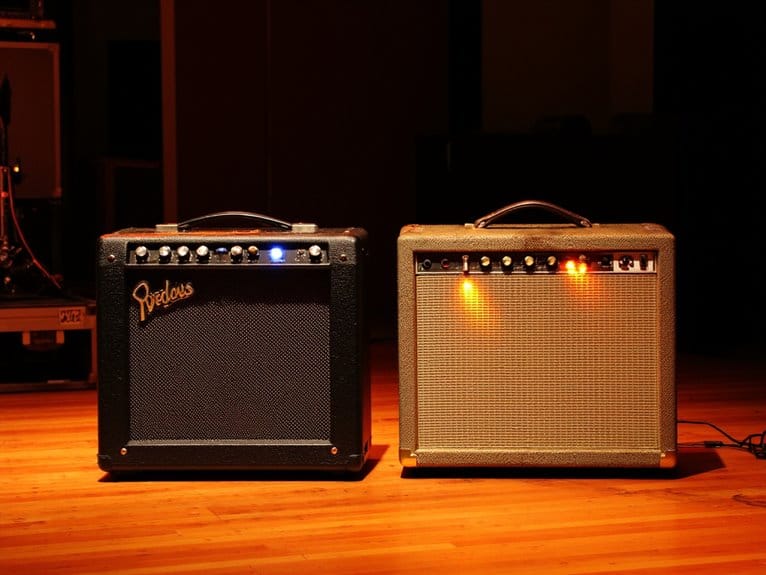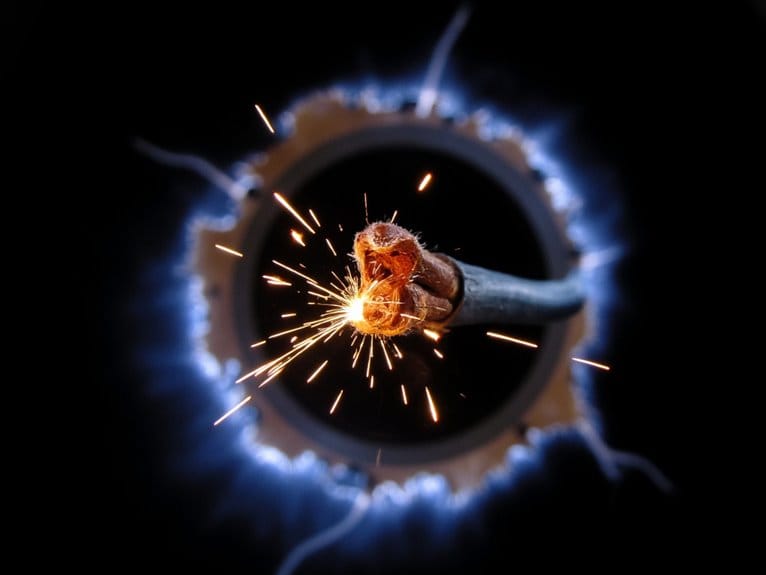Microphone Shock Mounts: What They Do and When to Use Them
You’ll need a microphone shock mount when recording with sensitive condensers or in environments with vibrations, since these specialized cradles use elastic bands to suspend your mic and prevent low-frequency rumbles, footsteps, and handling noise from reaching the diaphragm. They’re essential for studio work, podcasting, and broadcasting where even subtle vibrations can ruin your audio quality. While dynamic mics naturally resist interference, condensers with their higher sensitivity absolutely require shock mounts to maintain professional clarity and reduce post-production cleanup time that’ll save you hours later.
We are supported by our audience. When you purchase through links on our site, we may earn an affiliate commission, at no extra cost for you. Learn more.
Notable Insights
- Shock mounts use elastic bands or springs to suspend microphones, preventing vibrations from reaching the microphone diaphragm.
- They eliminate low-frequency rumbles, footsteps, HVAC noise, and handling sounds that can interfere with recording quality.
- Essential for studio recording sessions and podcasting to achieve professional audio clarity and reduce post-production cleanup time.
- Condenser microphones require shock mounts due to high sensitivity, while dynamic microphones benefit but are less dependent.
- Shock mounts protect delicate microphone components, extend equipment lifespan, and ensure consistent audio performance across environments.
What Is a Microphone Shock Mount?
When you’re setting up a professional recording environment, whether it’s for podcasting, voiceovers, or music production, you’ll quickly discover that even the slightest vibrations can wreak havoc on your audio quality.
A microphone shock mount is fundamentally a specialized cradle that holds your microphone using elastic bands or springs, creating a suspended barrier between your mic and its stand. These mounting techniques employ vibration isolation principles, preventing mechanical shocks from floor movements, desk bumps, or stand adjustments from reaching your microphone’s sensitive capsule.
The circular or oval frame design accommodates various microphone sizes while maintaining secure attachment to standard boom arms. By eliminating low-frequency rumble and handling noise, shock mounts dramatically improve recording clarity and professionalism. This protection is especially crucial for condenser microphones that capture subtle vibrations which can compromise audio quality. Shock mounts are typically designed for specific microphone models or series to ensure optimal compatibility and performance.
How Shock Mounts Function to Reduce Vibrations
Understanding how these mounting systems actually work reveals the elegant engineering behind their simple appearance, and I’ll admit the physics involved are more sophisticated than most people realize. Your shock mount creates a suspension system using elastic bands or springs that mechanically decouple the microphone from its stand, effectively blocking vibrations before they reach the capsule.
| Vibration Source | Mount Response |
|---|---|
| HVAC rumbles | Elastic suspension absorbs low frequencies |
| Footsteps | Cradle design distributes shock across directions |
| Desk tapping | Barrier prevents transmission to diaphragm |
| Equipment fans | Extended path reduces structure-borne noise |
| Handle adjustments | Dampening materials minimize contact vibrations |
This vibration absorption prevents mechanical noise from overwhelming your audio’s valuable frequencies, while the noise reduction maintains signal integrity without requiring extensive post-processing cleanup. Condenser microphones benefit most from shock mounts due to their enhanced sensitivity to vibrations and environmental interference. Professional shock mounts achieve optimal performance by maintaining a resonant frequency below 6-8 Hz, which maximizes the damping effect and vibration isolation capabilities.
Essential Scenarios for Using Shock Mounts
While shock mounts aren’t necessary for every recording situation, you’ll find they become absolutely essential in specific scenarios where vibration interference can ruin your audio quality.
I’ve discovered that studio recording sessions, podcast and broadcasting environments, and setups involving sensitive microphone types represent the three primary situations where shock mounts shift from helpful accessories to critical components of your recording chain. These mechanical fasteners suspend your microphone using elastics that effectively isolate it from stand-transmitted vibrations.
Understanding when you truly need shock mounts, rather than simply wanting them, will help you make informed decisions about your equipment investments and guarantee you’re addressing the actual vibration challenges in your specific recording environment.
Studio Recording Sessions
In my years working with studio setups, I’ve found that shock mounts become absolutely essential during professional recording sessions where even the slightest vibration can compromise your final product.
These isolation systems dramatically improve studio acoustics by preventing mechanical disturbances from corrupting your recordings, which directly enhances your recording techniques and overall workflow efficiency.
Here’s why shock mounts are vital for studio sessions:
- Vibration Control – They eliminate low-frequency rumbles from HVAC systems, foot traffic, and equipment that condenser microphones easily pick up.
- Movement Freedom – You can adjust stands, move around the booth, or handle scripts without generating handling noise that ruins takes. Most professional shock mounts use elastic bands or springs as their primary suspension components to achieve optimal vibration absorption.
- Equipment Protection – They cushion expensive microphones from accidental bumps during intense recording sessions, extending their lifespan considerably.
Podcast and Broadcasting
When you’re setting up your podcasting or broadcasting station, shock mounts transform from optional accessories into absolute necessities.
This is especially true since podcast microphones capture every subtle vibration that travels through your desk, mic stand, or boom arm.
Your podcast equipment becomes markedly more effective when you eliminate footsteps, HVAC rumbles, and desk tapping before they reach the microphone capsule.
These recording techniques save substantial post-production time, reducing your dependency on noise reduction plugins that can compromise natural sound quality. The elastic bands in shock mounts act as shock absorbers that store vibrations, preventing them from reaching your microphone.
Whether you’re recording in a home studio with creaky floors or a shared workspace with constant movement, shock mounts guarantee your voice remains clear without low-frequency interference that distracts listeners from your content. Podcasters using large diaphragm microphones are particularly susceptible to mechanical rumbles that can ruin otherwise perfect recordings.
Sensitive Microphone Types
Although every microphone benefits from vibration isolation to some degree, certain microphone types demand shock mounts as essential accessories rather than optional upgrades due to their inherent sensitivity characteristics and specialized applications.
Ribbon microphone applications require extreme vibration protection because their delicate ribbon elements can suffer permanent damage from mechanical shocks, while their bidirectional pickup patterns capture nuanced details that handling noise would easily compromise.
Condenser design features, including lightweight diaphragms and phantom power requirements, create exceptional sensitivity that picks up every vibration transmitted through mic stands. These microphones typically maintain a 200 Ohm output impedance that allows for long cable runs without signal degradation, but their sensitive components still require proper shock mounting regardless of cable length. The sensitive diaphragm movement in condensers makes them particularly susceptible to mechanical vibrations that can muddy otherwise clear recordings.
Here’s why these sensitive microphones need shock mounts:
- Ribbon mics – Fragile elements demand protection from any mechanical stress
- Condensers – Lightweight components amplify vibrations into audible noise
- Bi-directional patterns – Enhanced sensitivity captures unwanted handling sounds alongside desired audio
Condenser Vs Dynamic Microphones and Shock Mount Necessity
Understanding the relationship between microphone types and shock mount necessity starts with recognizing that condenser microphones, with their inherent high sensitivity and phantom power requirements, capture vibrations and handling noise far more readily than their dynamic counterparts.
While dynamic microphones offer natural resistance to environmental interference due to their electromagnetic design and lower sensitivity characteristics, they still benefit from vibration isolation in professional recording scenarios.
I’ve found that the decision to use shock mounts often depends on your specific microphone type, recording environment, and the level of audio quality you’re targeting for your project.
Many budget-friendly dynamic microphones like the Shure PGA48 come with integrated shock mounts to reduce handling noise, demonstrating that vibration isolation remains valuable even for less sensitive microphone designs.
Dynamic mics excel at rejecting background noise due to their cardioid pickup patterns, making them particularly effective for untreated rooms where environmental control is limited. This characteristic not only enhances vocal clarity but also minimizes any distractions from unwanted sounds in the background. As a result, dynamic mics are often considered a good mic for streaming, ensuring that the speaker’s voice stands out during recordings or live broadcasts. Their durability and reliability also make them a preferred choice for both beginners and seasoned professionals in various audio applications.
Key Benefits of Shock Mount Implementation
Five distinct advantages emerge when you implement shock mounts in your recording setup, each contributing to a measurably improved audio production experience that I’ve witnessed transform countless home studios and professional facilities.
These benefits directly impact your audio quality while supporting long-term microphone maintenance protocols. Implementing effective microphone maintenance tips can further enhance your recording experience by ensuring that your equipment remains in optimal condition. Regularly cleaning your microphone and storing it properly can prevent dust and moisture buildup, which can adversely affect sound quality. By prioritizing these practices, you can enjoy clearer audio and extend the lifespan of your gear.
- Enhanced Signal Clarity – You’ll eliminate low-frequency rumbles and mechanical vibrations that contaminate your recordings, allowing your microphone’s true frequency response to shine through without interference from HVAC systems or footsteps.
- Extended Equipment Lifespan – Your microphone’s delicate components receive protection from mechanical stress, reducing diaphragm fatigue and preventing costly repairs that I’ve seen devastate budgets.
- Professional Versatility – Whether you’re podcasting or recording vocals, shock mounts provide consistent isolation across environments, maintaining that studio-quality sound regardless of location.
Types of Shock Mount Systems Available
You’ll encounter three primary shock mount categories when shopping for microphone isolation solutions, each designed with specific suspension technologies and mounting approaches that address different recording scenarios.
The most fundamental distinction lies between elastic band suspension systems, which use flexible materials to absorb vibrations, and spring-loaded designs that employ mechanical components for isolation.
Though you’ll also need to examine whether universal mounts or custom-fitted options better suit your particular microphone’s dimensions and shape.
I’ve found that understanding these core differences helps narrow down your choices greatly, since each type offers distinct advantages regarding compatibility, isolation effectiveness, and overall durability for your specific recording environment.
Elastic Band Suspension Systems
When I first started working with shock mounts, I quickly discovered that elastic band suspension systems represent the most versatile and widely adopted solution for microphone vibration isolation.
These systems utilize rubber or synthetic elastic cords stretched around metal or plastic frames, creating a spider-like cradle that suspends your microphone centrally while preventing vibrations from traveling through mic stands.
Here’s what makes elastic systems particularly effective:
- Superior vibration absorption effectiveness through elastic bands that dissipate mechanical energy before it reaches your microphone
- Broad compatibility with various microphone sizes and weights, especially condenser mics in voice-over and podcasting setups
- Cost-effective performance balancing professional isolation capabilities with budget-friendly pricing
However, consider elastic cord durability limitations, as bands may lose elasticity over time and require periodic replacement for ideal performance.
Spring-Loaded Mount Designs
Three distinct engineering approaches define spring-loaded mount designs, and I’ve found these systems offer compelling advantages over elastic alternatives, particularly when you’re dealing with heavier microphones that demand rock-solid stability.
Coil spring mounts arrange metal springs around your microphone’s perimeter, while torsion designs use twisted spring loaded materials that resist directional movement with surgical precision. Multi-spring arrays strategically position several springs for optimized shock absorption, though I’ll admit the engineering can get wonderfully complex.
Hybrid mounts combine springs with rubber components for enhanced damping characteristics, and adjustable tension systems let you fine-tune isolation based on your specific microphone weight and studio conditions.
These designs excel in professional broadcast environments where elastic bands simply can’t provide sufficient support.
Universal Vs Custom Mounts
Two fundamental philosophies drive shock mount design decisions, and I’ve discovered that choosing between universal and custom systems often determines whether you’ll achieve professional-grade isolation or settle for adequate vibration control in your recording setup.
Universal mounts offer flexibility through adjustable mounting techniques that accommodate various microphone diameters, though they compromise precision for versatility.
Custom mounts represent design innovations engineered specifically for particular models, delivering superior performance by matching your mic’s exact weight and shape characteristics.
Here’s what you should consider:
- Universal mounts work well for multi-microphone setups but may require manual adjustments for ideal isolation.
- Custom mounts provide guaranteed compatibility and enhanced vibration damping for designated models.
- Professional studios typically favor custom systems for critical recording applications requiring minimal mechanical noise transfer.
Your choice depends on whether you prioritize flexibility or maximum isolation performance.
Frequently Asked Questions
Can Shock Mounts Affect Microphone Frequency Response or Audio Quality?
You’ll find that shock mounts don’t directly alter your microphone’s inherent frequency response, but they greatly improve audio quality by eliminating mechanical vibrations and low-frequency rumble.
When you’re recording, properly matched shock mounts prevent distortion, clipping, and unwanted noise artifacts that would otherwise muddy your signal. This allows your mic’s diaphragm to respond more accurately to sound waves and preserving the natural frequency response characteristics.
Do Shock Mounts Work Effectively With Microphone Windscreens and Pop Filters?
I’ve found shock mounts work exceptionally well with both accessories, though you’ll need to evaluate placement carefully.
Pop filter compatibility remains excellent since the filter positions in front of your microphone while the shock mount suspends it from below, creating complementary protection layers.
For windshield effectiveness, proper sizing becomes critical—oversized windscreens can strain the suspension system, potentially reducing vibration isolation performance and compromising your recording quality.
How Often Should Shock Mount Elastic Bands Be Replaced?
I’ve found that elastic band durability typically ranges from six months to two years, depending on usage frequency and environmental conditions, though I’ll admit I’ve pushed some bands well beyond their prime.
You should inspect your shock mount maintenance schedule every few months, looking for visible cracking, lost tension, or brittleness, since degraded elastics compromise vibration isolation and allow handling noise to creep into your recordings.
Can Shock Mounts Be Used With Microphones in Outdoor Recording Environments?
Absolutely, you’ll find shock mounts particularly valuable for outdoor recording, where environmental challenges like wind vibrations, traffic rumble, and handling noise constantly threaten your audio quality.
I’ve discovered that combining a quality shock mount with windshields greatly reduces those annoying low-frequency artifacts that plague outdoor sessions.
Though you’ll need to verify your mount matches your microphone’s weight and consider sturdy stands for best isolation.
On a final note
You’ll find that shock mounts aren’t just fancy accessories—they’re essential tools that’ll dramatically improve your recording quality by eliminating unwanted vibrations and handling noise. Whether you’re using a sensitive condenser mic in your home studio or a dynamic mic for live streaming, investing in a proper shock mount that matches your microphone’s specifications and your budget will pay dividends in cleaner, more professional-sounding audio that you’ll appreciate every time you listen back.

